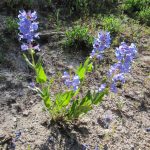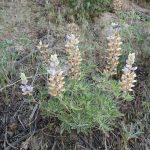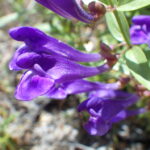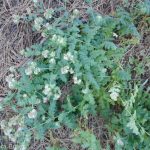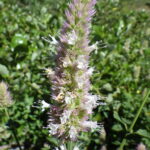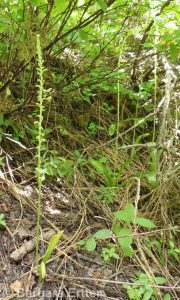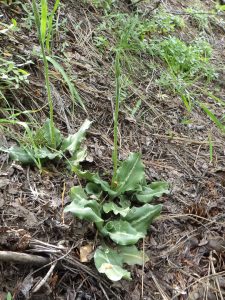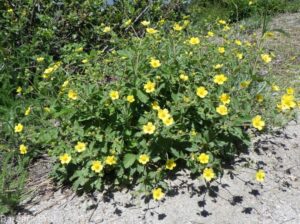MILEPOST 12 / UPPER DRY CREEK WILDFLOWER WALK
mid June to mid July
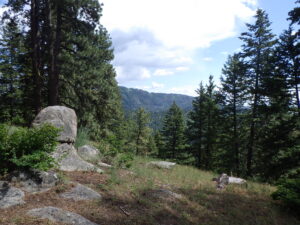
Enjoy spectacular mountain flowers and views along the Upper Dry Creek trail system from the Milepost 12 trailhead at the lower edge of the conifer forest, 2500 feet above the Boise Valley heat. This is the quickest driving access to a hike in the conifers for most residents of Boise, with the least carbon footprint. In addition to penstemon and other showy floral treasures, special treats of this wildflower walk include two native (albeit inconspicuous) orchids and several types of parasitic plants.
Description: The Upper Dry Creek trail system is on private land owned by the Grossman Family, with public access made possible (at least for now) thanks to a partnership with the Land Trust of the Treasure Valley and Ridge to Rivers. The wildflower walk begins at the side road taking off from the dogleg on Bogus Basin Road just past Milepost 12. Parking options are informal and very limited, so carpooling is recommended for groups; note that there is also roadside parking for several cars on the opposite side of Bogus Basin Road. The walk as described (Ponderosa Pine Overlook trail and Snowshow Hare Loop) is about 3 miles long, with about 350 foot elevation gain. The trails follow old logging roads, mostly fairly level but eroded in places and with some steep sections.
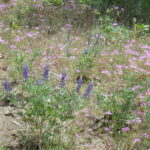
Begin by appreciating the wildflowers on the open sandy roadcuts, starting in the parking area itself. Among the locally common plants that might be in bloom are ragged-robin (Clarkia pulchella), sticky geranium (Geranium viscosissimum), wand phacelia (Phacelia heterophylla), Payette penstemon (Penstemon payettensis), sulphur buckwheat (Eriogonum umbellatum), common tarweed (Madia gracilis), and large-flowered groundsmoke (Gayophytum diffusum). Both silver lupine (Lupinus argenteus) and silky lupine (Lupinus sericeus) are present; the former has blue-violet flowers, while the latter has lavendar flowers that turn tan after being pollinated. Sharp eyes might even spot a small patch of narrowleaf skullcap (Scutellaria angustifolia) tucked under a bittercherry not far from Bogus Basin Road, or an odd-looking Franciscan broomrape (Aphyllon franciscanum, previously in Orobanche fasciculata) parasitizing the roots of adjacent wildflowers. Common shrubs at the trailhead include bittercherry (Prunus emarginata), chokecherry (Prunus virginiana), Macdougal’s rose (Rosa nutkana ssp. macdougalii), and Scouler’s willow (Salix scouleriana).
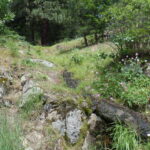
Take time to look for some interesting plants where a small streamlet flows over rocks, in the bend of the road just before the vehicle gate. The streamlet and adjacent steep slope is sensitive habitat, so please avoid the temptation to clamber up for a closer peek. In addition to field monkeyflower (Erythranthe arvensis, previously in Mimulus guttatus), wormleaf stonecrop (Sedum stenopetalum), brittlefern (Cystopteris fragilis), this is an excellent place to see pearlwort (Heterocodon rariflorum), a strong contender for our least visually attractive native wildflower. The species epithet refers to its rarely produced small blue chasmogamous bellflowers; the plant usually depends instead on inconspicuous self-pollinating cleistogamous flowers. It is nevertheless one of my favorite plants to find, and maybe you’ll be lucky to catch it with a blue flower or two! Late in the season, the dried streamlet can be white with the delicate blossoms of mountain or Gairdner’s yampah (Perideridia montana).

Following the road (DC5) beyond the gate, the vegetation gradually transitions from mid-elevation brushland to a shaded conifer forest, mostly Douglas-fir (Pseudotsuga menziesii) with a few ponderosa pine (Pinus ponderosa). Shrubs and small trees that make their appearance in the transition zone include snowbrush ceanothus (Ceanothus velutinus), Rocky Mountain maple (Acer glabrum), mountain snowberry (Symphoricarpos rotundifolius var. vaccinioides), mallowleaf ninebark (Physocarpus malvaceus), and even a few quaking aspen (Populus tremuloides), among others. One noteworthy roadside rosebush differs from the locally common solitary-flowered Macdougal’s rose (Rosa nutkana ssp. macdougalii) in having multiple flowers; it is probably a natural hybrid between Macdougal’s rose and interior rose (Rosa woodsii ssp. ultramontana), which is the common native rose below the conifer zone. The partly shaded roadbanks provide habitat for an increased diversity of wildflowers, notably Wilcox’s penstemon (Penstemon wilcoxii), branched phacelia (Phacelia ramosissima var. subglabra), diamond-petal farewell-to-spring (Clarkia rhomboidea), scarlet gilia (Ipomopsis aggregata), and western sweet-cicely (Osmorhiza occidentalis). A colony of horsemint (Agastache urticifolia) can be spotted (and smelled) at one bend in the road, while a patch of thimbleberry (Rubus nutkanus, previously R. parviflorus) grows at a brushy streamlet.

Keep to the left at unmarked junctions until reaching the intersection with the Snowshoe Hare Loop (DC4) at about 3/4 mile from the trailhead. To follow this wildflower walk as described, take the left-hand fork and do the loop in a clockwise direction. The road winds its way up the slope, with an abundance of sheltered north- and east-facing slopes in relatively dense forest. This is excellent habitat to look for the slender spires of Alaska rein-orchid (Platanthera unalascensis), a true native orchid that is fun to find even though the tiny green flowers are not particularly showy. Be sure to also peek under roadside thickets of Scouler’s willow (Salix scouleriana) for the distinctively mottled leaves of rattlesnake-plantain (Goodyera oblongifolia), another native orchid; the spikes of cream-colored flowers generally don’t develop until mid-summer. You might also notice the sweetly scented leaves of fragrant bedstraw (Galium trifolium) in the same habitat, more restrained than its rambuctious relative common bedstraw (Galium aparine). Sections of this loop are also brightened by large roadside stands of Idaho woodbeauty (Drymocallis glabrata), and if the timing is right (mid-summer), you can enjoy the lovely mountain hollyhock (Illiamna rivularis).
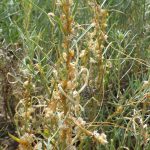
Snowshoe Hare Loop levels out for a while, before intersecting Doug Fir Trail (DC3). Turn right to continue on Snowshoe Hare Loop, down a fairly steep grade that can be slippery in spots. The road cuts through a dense thicket of snowbrush ceanothus (Ceanothus velutinus), whose white flower clusters and shiny resinous leaves can scent the air on a sunny day. Midway down the slope is a flat opening, possibly an old logging staging area, with abundant large-flowered groundsmoke (Gayophytum diffusum), common tarweed (Madia gracilis), and other annuals. In the center of the clearing are several large clumps of mountain stinging nettle (Urtica dioica ssp. gracilis); note the sharply toothed leaves and dangling inflorescences of tiny flowers, so you know what to avoid. Some of the rubber rabbitbrush (Ericameria nauseosa) at the lower edge of the clearing are unwilling hosts to tangled orange threads and small white flowers of western dodder (Cuscuta occidentalis), a native parasitic plant.
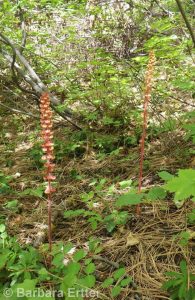
Ponderosa Pine Overlook is at the bottom of the grade, where Snowshoe Hare Loop reconnects with Ponderosa Pine trail. Several large boulders, scenic views, and a shaded flat opening make this site a destination point and pleasant place to take a break. A few hotrock penstemon (Penstemon deustus) grow among the boulders, but the flowers tend to finish blooming fairly early. Turn right on a well-shaded road to return to complete the loop and return to the trailhead, keeping a sharp eye out for more Alaska rein-orchid and, if you are lucky, some pinedrops (Pterospora andromedea) in the open forest floor. This curious plant, which lacks chlorophyll, has traditionally been categorized as a saprophyte, meaning a plant that obtains its nourishment from decomposing vegetation. It is now better interpreted to be a mycotroph, which is basically a freeloader on the forest’s intricate mycorrhizal network that connects fungal mycelium and tree roots. The mycelium effectively extends the nutrient and water collecting capacity of the tree roots, while obtaining photosynthetic nourishment produced by the tree; as far as is known, mycotrophs like pinedrops also tap into the network for their nourishment, but provide nothing in return.
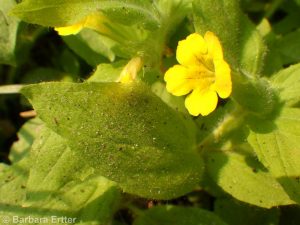
Once back at the trailhead, there is the option of a few bonus wildflowers by walking up Bogus Basin Road a couple of hundred feet to a roadside wet spot where a streamlet intersects the road. There are good-sized patches here of musk monkeyflower (Erythranthe moschata, previously in Mimulus), with its unusual slimy hairs, and American speedwell (Veronica americana). There might even be some flowering stalks of white bog-orchid (Platanthera dilatata), a much showier species than the Alaska rein-orchid.
PLANT LIST [updating needed]
NOTE: Please enjoy the wildflowers and leave them for others to enjoy. Because our unique local flora is already under pressure from invasive weeds and habitat loss, harvesting of native plants is not encouraged on this website, especially along popular trails.
Plants listed alphabetically by genus within category. * indicates native species
WILDFLOWERS
- *Yarrow (Achillea millefolium)
- *Nettleleaf giant hyssop, horsemint (Agastache urticifolia var. urticifolia)
- *Bigflower agoseris or mountain-dandelion (Agoseris grandiflora)
- *Annual agoseris or mountain-dandelion (Agoseris heterophylla)
- *Buckwheat broomrape (Aphyllon sp. nov., previously in Orobanche fasciculata)
- *Spreading dogbane (Apocynum androsaemifolium)
- *Douglas-fir dwarf-mistletoe (Arceuthobium douglasii)
- *Thymeleaf sandwort (Arenaria serpyllifolia var. serpyllifolia)
- *Heartleaf arnica (Arnica cordifolia)
- *Arrowleaf balsamroot (Balsamorhiza sagittata)
- *Rockcress (Boechera spp.) – several species present, difficult to identify
- *Corn gromwell (Buglossoides/Lithospermum arvensis)
- *Wing-fruited or white mariposa lily (Calochortus eurycarpus)
- *Fireweed (Chamaenerion angustifolium, previously in Epilobium) – late-blooming
- *Prince’s pine (Chimaphila umbellata)
- *Enchanter’s-nightshade (Circaea alpina ssp. pacifica)
- *Ragged-robin, pink fairies (Clarkia pulchella)
- *Diamond-petal clarkia or farewell-to-spring (Clarkia rhomboidea)
- *Common miner’s lettuce (Claytonia perfoliata ssp. intermontana, previously in Montia)
- *Blue-eyed Mary (Collinsia parviflora) – spring-blooming
- *Largeflower collomia (Collomia grandiflora)
- *Narrowleaf collomia, tiny trumpet (Collomia linearis)
- *Cryptantha (Cryptantha spp.) – several annual species present, difficult to identify
- *Western dodder (Cuscuta occidentalis)
- *Hoary or tansy-aster (Dieteria canescens, previously in Machaeranthera or Aster) – late-blooming
- *Larkspur (Delphinium sp.) – species difficult to distinguish
- *Mountain tansymustard (Descurainia incisa ssp. incisa)
- *Idaho woodbeauty, sticky cinquefoil (Drymocallis glabrata, formerly Potentilla glandulosa var. intermedia) – petals yellow, longer than sepals
- *Common woodbeauty, sticky cinquefoil (Drymocallis glandulosa var. glandulosa, previously in Potentilla) – petals cream-white to pale yellow, no longer than sepals
- *Common willow-herb (Epilobium ciliatum)
- *Starry sulphur-flowered buckwheat (Eriogonum umbellatum var. ellipticum) – umbels compound, blooming later than var. stragulum
- *Spreading sulphur-flowered buckwheat (Eriogonum umbellatum var. stragulum) – umbels simple, blooming earlier than var. ellipticum
- *Oregon sunshine (Eriophyllum lanatum var. integrifolium)
- *Western or Pursh’s wallflower (Erysimum capitatum var. purshii)
- *Field monkeyflower (Erythranthe arvensis, previously included in Mimulus guttatus)
- *Brewer’s monkeyflower (Erythranthe breweri, previously in Mimulus)
- *Elegant aster (Eucephalus elegans, previously Aster perelegans) – late-blooming
- *Showy aster (Eurybia conspicua, previously in Aster) – late-blooming
- *Checker, leopard, or chocolate lily (Fritillaria atropurpurea) – spring blooming
- *Cleavers, bedstraw, stickywilly, goose-grass (Galium aparine)
- *Twinleaf bedstraw (Galium bifolium)
- *Fragrant bedstraw (Galium triflorum)
- *Spreading or large-flowered groundsmoke (Gayophytum diffusum)
- *Sticky geranium (Geranium viscosissimum)
- *Bigleaf avens (Geum macrophyllum)
- *Western rattlesnake-plantain (Goodyera oblongifolia) – late-blooming
- *Blue stickseed (Hackelia micrantha)
- *Heterocodon, pearlflower (Heterocodon rariflorus) – visible flowers uncommon
- *Gooseberry-leaf alumroot (Heuchera grossulariifolia)
- *White hawkweed (Hieracium albiflorum)
- *Western or Scouler’s hawkweed (Hieracium scouleri, previously H. cynoglossoides)
- *Ballhead waterleaf (Hydrophyllum capitatum)
- *Mountain hollyhock, streambank globemallow (Illiamna rivularis)
- *Scarlet gilia, skyrocket, timpiute (Ipomopsis aggregata, previously in Gilia)
- *Prickly lettuce (Lactuca serriola)
- *Menzies’ pepperweed (Lepidium virginicum ssp. menziesii); also possible hybrid with *common pepperweed (Lepidium densiflorum)
- *Smallflower woodlandstar/prairiestar (Lithophragma parviflorum)
- *Stoneseed, Puccoon, Gromwell (Lithospermum ruderale)
- *Fernleaf biscuitroot (Lomatium [dissectum var.] multifidum)
- *Silver lupine (Lupinus argenteus)
- *Silky lupine (Lupinus sericeus)
- *Common tarweed (Madia gracilis)
- *False Solomon’s-seal (Maianthemum/Smilacina racemosa)
- *Bushy or smallflower blazingstar (Mentzelia dispersa)
- *Bigleaf sandwort (Moehringia macrophylla, previously in Arenaria)
- *Great Basin nemophila (Nemophila breviflora) – leaves all alternate, lobes acute
- *Smallflower nemophila (Nemophila parviflora var. parviflora) – leaves opposite, lobes blunt
- *Western sweet-cicely or sweetroot (Osmorhiza occidentalis)
- *Mountain sweet-cicely (Osmorhiza berteroi, previously O. chilensis)
- *Brown’s peony (Paeonia brownii) – spring-blooming
- *Hot-rock penstemon (Penstemon deustus)
- *Payette penstemon (Penstemon payettensis)
- *Wilcox’s penstemon (Penstemon wilcoxii)
- *Mountain, Gairdner’s, or western yampah (Perideridia montana, previously P. gairdneri ssp. borealis) – late-blooming
- *Wand or virgate phacelia (Phacelia heterophylla var. heterophylla)
- *Threadleaf phacelia (Phacelia linearis)
- *Branched phacelia (Phacelia ramosissima var. subglabra) – hairs can be irritating
- *Harsh popcorn-flower (Plagiobothrys hispidulus)
- *Alaska rein-orchid (Platanthera unalascensis, alternatively in Piperia or Habenaria)
- *Douglas’s knotweed (Polygonum douglasii)
- *Close-flowered or fruitleaf knotweed (Polygonum [polygaloides ssp.] confertiflorum)
- *Pinedrops (Pterospora andromedea) – late-blooming
- *Little buttercup (Ranunculus uncinatus)
- *Sheep sorrel (Rumex acetosella)
- *Narrowleaf skullcap (Scutellaria angustifolia ssp. angustifolia)
- *Wormleaf stonecrop (Sedum stenopetalum)
- *Western groundsel (Senecio integerrimus)
- *Menzies’s catchfly or silene (Silene menziesii)
- *Red sand-spurry (Spergularia rubra)
- *Common dandelion (Taraxacum officinale s.l.)
- *Yellow salsify or goat’s-beard (Tragopogon dubius)
- *White clover (Trifolium repens)
- *White-tip clover (Trifolium variegatum) – or similar species
- *Stinging nettle (Urtica dioica; both ssp. gracilis and ssp. holosericea present) – STINGING HAIRS
- *Goosefoot violet (Viola purpurea ssp. venosa) – spring-blooming
FERNS AND RELATIVES
- *Brittle fern (Cystopteris fragilis)
SHRUBS AND TREES (not all in bloom)
- *Rocky Mountain maple (Acer glabrum var. douglasii)
- *Western serviceberry, saskatoon (Amelanchier alnifolia)
- *Mountain big sagebrush (Artemisia tridentata ssp. vaseyana)
- *Creeping Oregon-grape (Mahonia repens)
- *Snowbrush ceanothus, sticky-laurel, mountain balm, tobacco-brush (Ceanothus velutinus var. velutinus)
- *Red-osier dogwood (Cornus stolonifera)
- *Rubber rabbitbrush (Ericameria nauseosa, previously in Chrysothamnus)
- *Syringa or Lewis’s mockorange(Philadelphus lewisii)
- *Mallowleaf ninebark (Physocarpus malvaceus)
- *Ponderosa pine (Pinus ponderosa)
- *Quaking aspen (Populus tremuloides)
- *Black cottonwood (Populus trichocarpa) – other species and/or hybrids possibly present
- *Bitter cherry (Prunus emarginata)
- *Chokecherry (Prunus virginiana var. melanocarpa)
- *Douglas-fir (Pseudotsuga menziesii)
- *Wax currant (Ribes cereum)
- *Macdougal’s, Nootka, or Spalding’s rose (R. nutkana subsp. macdougalii) — large solitary flowers; also probable hybrids with *Interior or Wood’s rose (Rosa woodsii subsp. ultramontana)
- *Obtuse- or Round-leaf dog rose (Rosa obtusifolia) – like dog rose (R. canina), but leaflets hairy
- *Thimbleberry (Rubus nutkanus, previously R. parviflorus)
- *Blue elderberry (Sambucus cerulea, alternatively S. mexicana)
- *Sandbar willow (Salix exigua)
- *Scouler’s willow (Salix scouleriana)
- *Willows (Salix spp.) – several other difficult-to-distinguish species
- *White or birchleaf spirea (Spiraea lucida/betulifolia)
- *Mountain-ash (Sorbus scopulina)
- *Mountain snowberry (Symphoricarpos rotundifolius var. vaccinioides, previously S. oreophilus var. utahensis) – corolla lobes much shorter than tube
SIGNIFICANT NOXIOUS WEEDS (some not yet in bloom, but evident)
- *Cheatgrass (Bromus tectorum)
- *Rush skeletonweed (Chondrilla juncea)
- *Feral or Cereal Rye (Secale cereale)
- *Tumble or Jim Hill mustard (Sisymbrium altissimum)
OTHER GRASSES & GRASSLIKE PLANTS
- *Rattlesnake brome (Bromus briziformis)
- *Brome (perennial Bromus spp.) – species difficult to distinguish, both native and non-native
- *Geyer’s sedge (Carex geyeri)
- *Ross’s sedge (Carex rossii)
- *Sedge (Carex spp.) – other species difficult to distinguish
- *Annual hairgrass (Deschampsia danthonoides)
- *Slender hairgrass (Deschampia elongata)
- *Wild-rye (Elymus spp.) – species difficult to distinguish
- *Common toad rush (Juncus bufonius var. bufonius)
- *Daggerleaf rush (Juncus ensifolius, stamens 3) or *Rocky Mountain rush (Juncus saximontanus, stamens 6)
- *Western rush (Juncus occidentalis; capsule apex ridged) or similar species
- *Bulbous bluegrass (Poa bulbosa)
- *Sandberg bluegrass (Poa secunda)
- *Intermediate wheatgrass (Thinopyrum intermedium, alternatively in Elytrigia or Elymus) – planted for erosion control

